
Wine Culture and Information since 2002 - Volume 22
 Wine Culture and Information since 2002 - Volume 22 |
|
Issue 187, September 2019 |
Contents |
|
|
2019: a Lower Quantity Harvest However of Quality |
|
In this period of year, wineries are about to scrupulously get ready to one of the key events of the entire season: harvesting. To tell the truth, there are already many wineries that have begun the important work of harvesting grapes, not only those that are mainly involved with the production of sparkling wines but also, and above all, those of southern Italy. The summer, which is now about to come to the end, has definitely been the factor that more than any other has determined the fate of vineyards, one of the hottest seasons of the last decades. The trend of this summer 2019, in fact, has been rather bizarre as, in addition to the sultry and torrid heat, there have also been copious torrential rains and hail, with severe damage to crops in the affected areas. In addition, September weather report forecasts again rainfall and thunderstorms: it is not exactly good news for those who are busy with the grape harvesting in this month. A meteorological scenario which is more similar to the one in the tropical areas of the world rather than those of the Mediterranean area. The severity of the summer heat has, however, caused many difficulties to vintners, in particular for the vineyards which, having to face long periods of drought, the poor vines had to sustain important conditions of water suffering. All this inevitably led to a lower production of grapes due to the difficulties sustained by the vines in their biological cycle. The first estimates, in fact, suggest a lower production compared to 2018, however many have been emphasized that, in qualitative terms, the grapes are healthy and giving high hopes for the wines of vintage 2019. However, it is just about estimates and predictions – something happening every year – with the aim of making a sensation about the quality of a product that does not yet exist. The confirmation or the denial, inevitably and as always, will be unequivocally decreed by the glasses when the bottles of this vintage will be uncorked in 2020. Of course, this year, just like the past ones, could not miss the eternal challenge “Italy against all” – and, in particular, against France – for the coveted trophy to be won by the country that will make more wine than any other else. Good news for those who care about the fate of this competition: Italy will again be on the top of the podium with an estimated production of between 47 and 49 million hectoliters of wine. Our French cousins, according to the estimates, will only make a quantity of wine between 43 and 46 million hectoliters, while, as for the other cousins of Spain, the estimate stands between 40 and 44 million hectoliters. In all cases – it must be said – the estimates are down compared to 2018 vintage and it must also be noted, in this regard, the last vintage was particularly abundant. Therefore, also for 2019, Italy maintains the primacy on the quantity of wine produced or presumed such. The estimates for 2019 harvest, according to Coldiretti and Confagricoltura (the main Italian organizations of agriculturists), confirm Veneto as the main producer in Italy – with 25% of the national total – followed by Apulia with 18%, Emilia Romagna with 17% and Sicily with 8%. As for the destination of the grapes that are being harvested these days in Italy, about 70% is destined to the production of DOCG, DOC and IGT wines. The remaining 30% is instead destined to the production of Vini da Tavola (Table Wines), that is those belonging to the lowest level provided by the Italian quality system. Still on the subject of statistics, in 2019 there are 567 varieties of grapes registered with the “National Register of Vine Varieties” at the Italian Ministry of Agricultural, Food and Forestry Policies, a number which obviously does not include the clones of the individual varieties. A decidedly considerable number – which is unparalleled all over the world – and which emphasizes the enormous wine-growing heritage and biodiversity of Italy. As a matter of comparison, France has in its territory only 278 distinct varieties. Still remaining in the context of the numbers describing Italian viticulture and wine making, according to the data issued by the Italian Ministry of Agricultural, Food and Forestry Policies, in Italy are currently recognized 74 DOCG, 334 DOC and 118 IGT areas. With regard to the production of the Italian vineyard, it has been estimated an average decrease of 6% compared to 2018. The lower production, due to the meteorological and climatic trend of 2019, has been recorded in almost every region of Italy. In particular, Friuli Venezia Giulia recorded a drop of 20%, Umbria -13%, Veneto and Campania -12%, Trentino Alto Adige -11%, Marche -10%, Abruzzo, Liguria and Valle d'Aosta -8%, Piedmont -7.7%, Emilia Romagna and Sardinia -5.5%, Sicily -5%, Lombardy -3.5%. It must be said some regions have instead recorded an increase in production, in particular Latium with +16%, Molise +10%, Calabria +9%, Apulia +2.9%. In any case, viticulture and enology remain an extremely important department for the Italian food industry. In 2019, in fact, there are 300,000 companies having vineyards corresponding to a planted area of 652,000 hectares, of which 50,000 have wine-making facilities, making a total income of around 10 billion euros and an export value of 6.2 billion euros. In any case, these data could change in consequence of the meteorological and climatic trend that will characterize the harvesting period – currently underway in many regions and for different styles of wines – and which will certainly continue until October for the late ripening varieties. In fact, weather forecasts predict changes with important rainfall in September, hoping they will not cause harmful events such as hail. Saved the case of inauspicious episodes, the quality of grapes which will enter the wineries seems to be very good, a condition allowing us to wish the production of wines of excellent quality, a news that – of course – makes everyone happy and content. The result of the work of vintners and winemakers will actually become tangible in the spring of 2020, when the first bottles of the 2019 vintage will be uncorked. There will be exceptions, just like every year, for those wines which are ready before the end of the year and that however will give indications about quality. For what we can do, we dearly wish all the very best to winemakers and to all those who are involved in grape harvesting and wine production. Of course, we look forward to toasting with your 2019 wines to your work that is noble and precious. Whatever happens, however it is, it will certainly be a success. Antonello Biancalana
|
||||
Contrasts of Pinotage and TannatTwo different grapes with different stories, capable of making wines with distinct personalities and with a character that can be defined quite opposite however linked by the same red color |
|
Each wine country in the world defines, in a more or less evident way, its enological identity with few grape varieties, sometimes even with just one. This happens in any wine making country of the world, even in those that boast a huge heritage of grapes in their vineyards. In many cases, these are not even native grapes, indeed they are varieties imported from other countries, often introduced by settlers or emigrants who planted them with the intention of making the wine they were used to in their countries of origin. This aspect is definitely interesting because it has sometimes happened a typical variety of a particular country – where its presence is historically recorded – is actually capable of making “better” wines in the countries where it is, so to speak, a foreigner. Often it is a success capable of changing the enological fate of that country and, at the same time, reviving the interest in the grapes that determined it. Sometimes it happens two varieties, consolidated in their countries of origin, meet elsewhere, giving life – from their union – to a new grape capable of giving an enological identity to that country. This is the case, for example, of Pinotage, a red grape born in South Africa and which today is one of the identifying varieties of this country. Moreover, let's think about the many grapes introduced by emigrants in the countries of destination and which have been able to give a strong enological identity to those places where, historically, no wines were produced or in any case non important ones. There are many examples that could be mentioned, two in particular and which concern Latin American countries. Today, in fact, when we talk about Malbec – a grape originating from France, in the Bordeaux area, in particular – the most common association is Argentina where it was capable of making wines of primary importance. The same can be said for Tannat – one of the two grapes protagonists of the tasting by contrast of this month – a variety of French origin and which today has become the enological glory of Uruguay.
|
|
When we talk about the wines of South Africa, the first grape which comes to mind is undoubtedly Pinotage. Not only because this variety was created in this country, but in particular for the fact it is practically cultivated in South Africa only. It is therefore a variety that strongly and indissolubly identifies the enology of South Africa, a country that – in any case - - boasts a winemaking tradition of some centuries and that was introduced by Dutch traders. The story tells, in fact, the first vineyards in South Africa were planted in 1652 by Jan van Riebeeck, with the aim – among the many things – of establishing an agricultural community at the “Cape Colony”, near the place where Cape Town is now located. The first vineyards were planted with varieties imported from Germany, from the Rheingau region, which were followed, in the following centuries, by grapes from other wine-growing areas, in particular from France. The history of Pinotage is decidedly more recent and it is a cross created at the University of Stellenbosch in 1925 by Abraham Izak Perold, then professor of viticulture in that university. The intent was to create a new variety by crossing Cinsaut – known at that time with the name Hermitage – with Pinot Noir, in order to combine power with elegance. The result, years later, took the name of Pinotage, combining the names of the two grapes. This new variety, in addition to identifying South Africa, is practically cultivated in this area only, although it has taken many years since its invention before becoming successful with its wines. The first bottles that began to be noticed were in fact produced in the late 1950s. A controversial grape, easy to grow and make wine, Pinotage is however capable of making interesting wines both in inert containers and in cask, despite having a tendency to develop excessive amounts of isoamyl acetate which sometimes characterizes the olfactory profile. This substance, in fact, as it is well-known, recalls the aroma of banana and, when found in excessive quantities in a wine, develops not exactly pleasant aromas.
|
||||
|
Tannat undeniably owes its fame to the wines of Madiran AOC, in the south-western territory of France, near the Pyrenees. As far as its origin is concerned, it is believed Tannat is an indigenous variety of the neighboring Basque Country, therefore in the territory of Spain. Tannat is known for its wines characterized by the high content of tannins, therefore with a marked astringency. It is also supposed this characteristic gave the origin of its name, precisely to emphasize the strong presence of tannins that are perceived to the taste in its wines. In addition to Madiran, which is certainly among the most important enological expressions for this variety, Tannat is also used for wines produced in neighboring areas and is also used, in small quantities, in those of Cahors AOC appellation. Tannat has also enjoyed enormous success on the other side of the Atlantic Ocean, in particular in Uruguay where, today, this variety is considered as the national grape and the planted acreage is even greater than France. Tannat was imported to Uruguay thanks to the Basque settlers who introduced it to these lands in the 19th century. This variety quickly spread in Uruguay, so much so that today it is the most cultivated variety in the country and is capable of making less astringent wines than those of Madiran as well as having a distinct organoleptic profile. The abundant presence of tannins requires, in any case, a wine making practice such as to allow the production of less astringent wines with a more elegant character, a result that is obtained mainly with the long aging in cask. In fact, wines produced with 100% Tannat are frequently aged in cask for periods of even two years, in order to make tannins more pleasant and less aggressive. The modern trend, however, is to make wines from Tannat grapes with a rounder character, often combining varieties such as Merlot, known for their round touch. Finally, Tannat is definitely conquering other wine making countries of the world – including Italy – often combined with local grapes in order to give body and structure.
|
The tasting by contrast of this month will have as protagonists wines produced in the two hemispheres of the planet, extraordinarily distant, in particular from the geographical point of view. As for Pinotage, in fact, the choice is necessarily made in favor of a bottle produced in South Africa, in particular in the interesting territory of Stellenbosch. This variety, over the time, has proven to have interesting enological versatility, even with cask aging, therefore – with the aim of balancing the practically mandatory choice of Tannat – the wine we will examine is aged in this type of container. As for Tannat, our choice is in favor of a bottle belonging to Madiran AOC, certainly the most representative of France and with a typically astringent character, aged in cask. In both cases we will make sure the wines are produced with the respective varieties alone and served in tasting glasses at a temperature of 18 °C (65 °F). Let's pour the two wines into their respective glasses and start the tasting by contrast of this month, starting from the Stellenbosch Pinotage. The sensorial analysis of the wines begins with the evaluation of the appearance, for which we will need a white surface to be used for the observation of the glasses. Let's tilt the glass of the Stellenbosch Pinotage over the white surface and observe the wine at the base: we will notice an intense and brilliant ruby red color, with a rather low transparency, so that the object placed in contrast between the glass and the white surface is scarcely visible. The nuance of this wine, observed at the edge of the glass, towards the opening, confirms the ruby red color, often accompanied by evident purple shades. Let's now move on to the evaluation of the appearance of the Madiran, that is to the wine produced with Tannat, and let's tilt the glass over the white surface. The color of this wine is intense and dark ruby red, with a decidedly low transparency. The nuance of Tannat, observed at the edge of the glass, reveals a ruby red color in which can sometimes be seen a purple shade. The olfactory profiles of Pinotage and Tannat are characterized by the rich expression of red and black fruits, of course, with substantial differences. These qualities are strongly affected both by the vinification method and by time. Of the two varieties, the one expressing the greatest variability in aromas is Pinotage, which – according to the clone used and the vinification method – can develop more or less important quantities of isoamyl acetate, notoriously responsible for the aroma of banana. This characteristic has in fact often been the subject of criticism, even severe, in wines produced with Pinotage – especially those of the past – because, when present in excessive quantities, it gives a distinctly “chemical” character. Another characteristic of Pinotage is that it tends excessively to the development of volatile acidity, which – in case it is not correctly prevented – can easily give the wines aromas that recall nail polish or solvent substances, including an unpleasing slight touch in which can be recognized vinegar. Let's proceed with the evaluation of the olfactory profile of our two wines, starting with the Stellenbosch Pinotage. By keeping the glass in vertical position and, without swirling, we proceed with the first smell in order to appreciate the opening aromas of the South African wine. To the nose can be perceived intense and clean aromas of black cherry, raspberry and blackberry, to which can follow – in some cases – a touch of banana. Let's swirl the glass, an operation that will favor the development of other aromas, and proceed with the second smell. The profile of Stellenbosch Pinotage is completed with plum, violet, cyclamen and, because of the aging in wood, tertiary aromas in which we recognize vanilla and a hint of smoke. Let's now evaluate the olfactory profile of Madiran, produced with Tannat, and proceed with the analysis of the opening aromas. To the nose we can perceive clear and intense aromas of plum, black cherry, raspberry and blueberry. After having swirled the glass, the second smell completes the profile of Tannat with blackberry and violet, in addition to the evident tertiary aromas, given by the aging in wood, of vanilla, chocolate and tobacco. The evaluation of the gustatory profiles clearly highlights the differences between Pinotage and Tannat, in particular the sensations of astringency and structure. It must be said Pinotage is a grape capable of making wines with a good structure and appreciable astringency, however – in this sense – it cannot compare to the power of Tannat, among the grapes with the highest content of polyphenols used for wine production. In this regard, it should be noticed that – as far as polyphenol content is concerned – only Sagrantino has a higher quantity than Tannat. The first wine we examine is Stellenbosch Pinotage. The attack of the South African wine is characterized by good structure and acidity, with a perceptible and balanced sensation of astringency. In the mouth are perceived flavors of black cherry, raspberry and blackberry. Let's move on to the gustatory evaluation of Madiran and take a sip in order to evaluate the attack. Tannat is perceived in the mouth with the well-known power produced by its tannins, therefore both astringency and structure will be very evident, clearly more intense than Pinotage. It can also be perceived a pleasant crispness to which are added the flavors of plum, blueberry, raspberry and black cherry. Let's finish the tasting by contrast of this month with the evaluation of the final sensations the two wines leave in the mouth, in particular the taste-olfactory persistence. The finish of Stellenbosch Pinotage is persistent, leaving in the mouth the characteristic flavors of black cherry, blackberry and raspberry, as well as a pleasing sensation of crispness that, in our case, is balanced by the roundness given by the aging in wood. The finish of Tannat – therefore of Madiran AOC – is equally persistent and, in this case, the perception of astringency and structure are decidedly more intense when compared to Pinotage. In the mouth are perceived flavors of plum, raspberry, blueberry and black cherry, followed by the characteristic and pleasant crispness of acidity, also in this case balanced by the aging in wood. Let's now place the two glasses side by side and re-evaluate the aromas – Pinotage first, then Tannat – followed by a new gustatory evaluation. The differences, in particular to the taste, structure and astringency, are clearly evident.
|
||||||||
Wines of the Month |
|
|
|
Score legend Prices are to be considered as indicative. Prices may vary according to the country or the shop where wines are bought |
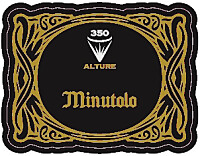
|
|
Alture Minutolo 2017 |
|
| Paolo Leo (Apulia, Italy) | |
 Minutolo Minutolo | |
| Price: € 10.90 | Score: |
 Brilliant straw yellow and nuances of straw yellow, very transparent. Brilliant straw yellow and nuances of straw yellow, very transparent. Intense, clean, pleasing and refined, starts with hints of apple, plum
and citron followed by aromas of passion fruit, hawthorn, mango, jasmine,
pear, peach, linden and mineral. Intense, clean, pleasing and refined, starts with hints of apple, plum
and citron followed by aromas of passion fruit, hawthorn, mango, jasmine,
pear, peach, linden and mineral.
 Crisp attack and however balanced by alcohol, good body, intense
flavors, agreeable. Crisp attack and however balanced by alcohol, good body, intense
flavors, agreeable.
 Persistent finish with flavors of apple, plum and passion fruit. Persistent finish with flavors of apple, plum and passion fruit. 3 months in steel tanks, 1 month in bottle. 3 months in steel tanks, 1 month in bottle. |
|
 Crustacean and vegetable appetizers, Risotto with crustaceans, Sauteed fish, Eggs, Dairy products Crustacean and vegetable appetizers, Risotto with crustaceans, Sauteed fish, Eggs, Dairy products |
|
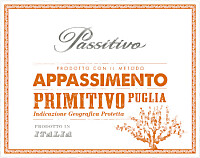
|
|
Passitivo 2016 |
|
| Paolo Leo (Apulia, Italy) | |
 Primitivo Primitivo | |
| Price: € 15.60 | Score: |
 Intense ruby red and nuances of ruby red, little transparency. Intense ruby red and nuances of ruby red, little transparency. Intense, clean, pleasing and refined, starts with hints of blackberry,
plum and black cherry followed by aromas of dried violet, blueberry,
raspberry, tobacco, carob, vanilla and menthol. Intense, clean, pleasing and refined, starts with hints of blackberry,
plum and black cherry followed by aromas of dried violet, blueberry,
raspberry, tobacco, carob, vanilla and menthol.
 Properly tannic attack and however balanced by alcohol, good body,
intense flavors, pleasing roundness. Properly tannic attack and however balanced by alcohol, good body,
intense flavors, pleasing roundness.
 Persistent finish with flavors of blackberry, plum and black cherry. Persistent finish with flavors of blackberry, plum and black cherry. Made with dried grapes. A part ages for 12 months in barrique. Made with dried grapes. A part ages for 12 months in barrique. |
|
 Roasted meat, Stewed meat with mushrooms, Hard cheese Roasted meat, Stewed meat with mushrooms, Hard cheese |
|
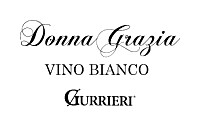
|
|
Donna Grazia Bianco |
|
| Gurrieri (Sicily, Italy) | |
 Nero d'Avola, Frappato Nero d'Avola, Frappato | |
| Price: € 16.00 | Score: |
 Intense straw yellow and nuances of straw yellow, very transparent. Intense straw yellow and nuances of straw yellow, very transparent. Intense, clean, pleasing and refined, starts with hints of apple, plum
and broom followed by aromas of medlar, hawthorn, pear, citrus fruits and
pineapple. Intense, clean, pleasing and refined, starts with hints of apple, plum
and broom followed by aromas of medlar, hawthorn, pear, citrus fruits and
pineapple.
 Crisp attack and however balanced by alcohol, good body, intense
flavors, agreeable. Crisp attack and however balanced by alcohol, good body, intense
flavors, agreeable.
 Persistent finish with flavors of apple, plum and pineapple. Persistent finish with flavors of apple, plum and pineapple. 6 months in steel tanks, at least 3 months in bottle. 6 months in steel tanks, at least 3 months in bottle. |
|
 Fish appetizers, Pasta with vegetables and crustaceans, Sauteed fish, Eggs, Dairy products Fish appetizers, Pasta with vegetables and crustaceans, Sauteed fish, Eggs, Dairy products |
|
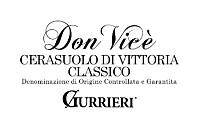
|
|
Cerasuolo di Vittoria Classico Don Vicè 2015 |
|
| Gurrieri (Sicily, Italy) | |
 Nero d'Avola, Frappato Nero d'Avola, Frappato | |
| Price: € 18.50 | Score: |
 Intense ruby red and nuances of garnet red, moderate transparency. Intense ruby red and nuances of garnet red, moderate transparency. Intense, clean, pleasing and refined, starts with hints of black
cherry, raspberry and blackberry followed by aromas of dried violet,
strawberry, plum, dried rose, carob and vanilla. Intense, clean, pleasing and refined, starts with hints of black
cherry, raspberry and blackberry followed by aromas of dried violet,
strawberry, plum, dried rose, carob and vanilla.
 Properly tannic attack and however balanced by alcohol, good body,
intense flavors, agreeable. Properly tannic attack and however balanced by alcohol, good body,
intense flavors, agreeable.
 Persistent finish with flavors of black cherry, raspberry and
blackberry. Persistent finish with flavors of black cherry, raspberry and
blackberry.
 18 months in cask and steel tanks, at least 12 months in bottle. 18 months in cask and steel tanks, at least 12 months in bottle. |
|
 Stuffed pasta with mushrooms, Roasted meat, Broiled meat and barbecue, Stewed meat with mushrooms Stuffed pasta with mushrooms, Roasted meat, Broiled meat and barbecue, Stewed meat with mushrooms |
|
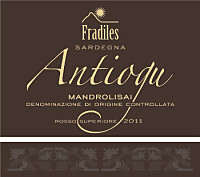
|
|
Mandrolisai Rosso Superiore Antiogu 2015 |
|
| Fradiles (Sardinia, Italy) | |
 Bovale Sardo, Cannonau, Monica, Other Grapes Bovale Sardo, Cannonau, Monica, Other Grapes | |
| Price: € 10.50 | Score: |
 Intense ruby red and nuances of garnet red, little transparency. Intense ruby red and nuances of garnet red, little transparency. Intense, clean, pleasing and refined, starts with hints of black
cherry, plum and blackberry followed by aromas of dried violet, blueberry,
raspberry, tobacco, chocolate, mace, vanilla and menthol. Intense, clean, pleasing and refined, starts with hints of black
cherry, plum and blackberry followed by aromas of dried violet, blueberry,
raspberry, tobacco, chocolate, mace, vanilla and menthol.
 Properly tannic attack and however balanced by alcohol, good body,
intense flavors, pleasing roundness. Properly tannic attack and however balanced by alcohol, good body,
intense flavors, pleasing roundness.
 Persistent finish with flavors of black cherry, plum and blackberry. Persistent finish with flavors of black cherry, plum and blackberry. 12 months in steel tanks, 12 months in cask, 4 months in bottle. 12 months in steel tanks, 12 months in cask, 4 months in bottle. |
|
 Broiled meat and barbecue, Roasted meat, Stewed meat with mushrooms, Hard cheese Broiled meat and barbecue, Roasted meat, Stewed meat with mushrooms, Hard cheese |
|
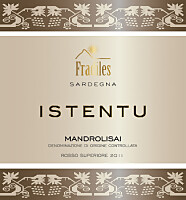
|
|
Mandrolisai Rosso Superiore Istentu 2015 |
|
| Fradiles (Sardinia, Italy) | |
 Bovale Sardo (50%), Cannonau (25%), Monica (20%), Other Grapes (5%) Bovale Sardo (50%), Cannonau (25%), Monica (20%), Other Grapes (5%) | |
| Price: € 21.50 | Score: |
 Intense ruby red and nuances of garnet red, little transparency. Intense ruby red and nuances of garnet red, little transparency. Intense, clean, pleasing and refined, starts with hints of black
cherry, plum and blueberry followed by aromas of violet, raspberry,
blackberry, peanut, chocolate, tobacco, vanilla and menthol. Intense, clean, pleasing and refined, starts with hints of black
cherry, plum and blueberry followed by aromas of violet, raspberry,
blackberry, peanut, chocolate, tobacco, vanilla and menthol.
 Properly tannic attack and however balanced by alcohol, good body,
intense flavors, pleasing roundness. Properly tannic attack and however balanced by alcohol, good body,
intense flavors, pleasing roundness.
 Persistent finish with flavors of black cherry, plum and blueberry. Persistent finish with flavors of black cherry, plum and blueberry. 12 months in cask, 6 months in barrique, 6 months in bottle. 12 months in cask, 6 months in barrique, 6 months in bottle. |
|
 Roasted meat, Stewed and braised meat with mushrooms, Hard cheese Roasted meat, Stewed and braised meat with mushrooms, Hard cheese |
|
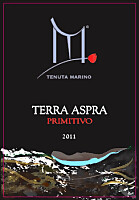
|
|
Matera Primitivo Terra Aspra 2011 |
|
| Tenuta Marino (Basilicata, Italy) | |
 Primitivo Primitivo | |
| Price: € 26.80 | Score: |
 Intense ruby red and nuances of orange red, little transparency. Intense ruby red and nuances of orange red, little transparency. Intense, clean, pleasing and refined, starts with hints of prune,
blackberry jam and dried violet followed by aromas of black cherry jam,
raspberry jam, chocolate, tobacco, leather, licorice, vanilla and menthol. Intense, clean, pleasing and refined, starts with hints of prune,
blackberry jam and dried violet followed by aromas of black cherry jam,
raspberry jam, chocolate, tobacco, leather, licorice, vanilla and menthol.
 Properly tannic attack and however balanced by alcohol, good body,
intense flavors, pleasing roundness. Properly tannic attack and however balanced by alcohol, good body,
intense flavors, pleasing roundness.
 Persistent finish with flavors of prun, blackberry jam and black
cherry jam. Persistent finish with flavors of prun, blackberry jam and black
cherry jam.
 8 months in cask. 8 months in cask. |
|
 Roasted meat, Broiled meat and barbecue, Stewed meat with mushrooms, Hard cheese Roasted meat, Broiled meat and barbecue, Stewed meat with mushrooms, Hard cheese |
|
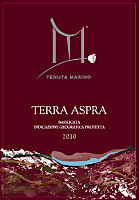
|
|
Terra Aspra Aglianico 2010 |
|
| Tenuta Marino (Basilicata, Italy) | |
 Aglianico Aglianico | |
| Price: € 24.40 | Score: |
 Intense ruby red and nuances of garnet red, little transparency. Intense ruby red and nuances of garnet red, little transparency. Intense, clean, pleasing, refined and elegant, starts with hints of
plum, blackberry and dried violet followed by aromas of black cherry,
blueberry, chocolate, cinnamon, tobacco, licorice, mace, vanilla and
menthol. Intense, clean, pleasing, refined and elegant, starts with hints of
plum, blackberry and dried violet followed by aromas of black cherry,
blueberry, chocolate, cinnamon, tobacco, licorice, mace, vanilla and
menthol.
 Properly tannic attack and however balanced by alcohol, good body,
intense flavors, pleasing roundness. Properly tannic attack and however balanced by alcohol, good body,
intense flavors, pleasing roundness.
 Persistent finish with flavors of plum, blackberry and black cherry. Persistent finish with flavors of plum, blackberry and black cherry. 12 months in cask, 4 months in bottle. 12 months in cask, 4 months in bottle. |
|
 Roasted meat, Stewed and braised meat with mushrooms, Hard cheese Roasted meat, Stewed and braised meat with mushrooms, Hard cheese |
|

|
|
Aglianico del Vulture Titolo 2017 |
|
| Elena Fucci (Basilicata, Italy) | |
 Aglianico Aglianico | |
| Price: € 33.00 | Score: |
 Intense ruby red and nuances of ruby red, little transparency. Intense ruby red and nuances of ruby red, little transparency. Intense, clean, pleasing, refined and elegant, starts with hints of
blackberry, plum and blueberry followed by aromas of black cherry, violet,
raspberry, geranium, chocolate, cinnamon, tobacco, carob, rosemary, vanilla
and menthol. Intense, clean, pleasing, refined and elegant, starts with hints of
blackberry, plum and blueberry followed by aromas of black cherry, violet,
raspberry, geranium, chocolate, cinnamon, tobacco, carob, rosemary, vanilla
and menthol.
 Tannic attack and however balanced by alcohol, full body, intense
flavors, agreeable. Tannic attack and however balanced by alcohol, full body, intense
flavors, agreeable.
 Very persistent finish with long flavors of blackberry, plum and black
cherry. Very persistent finish with long flavors of blackberry, plum and black
cherry.
 12 months in barrique, 12 months in bottle. 12 months in barrique, 12 months in bottle. |
|
 Game, Roasted meat, Stewed and braised meat, Hard cheese Game, Roasted meat, Stewed and braised meat, Hard cheese |
|
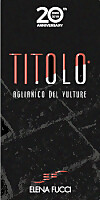
|
|
Aglianico del Vulture Titolo 20th Anniversary 2017 |
|
| Elena Fucci (Basilicata, Italy) | |
 Aglianico Aglianico | |
| Price: € 85.00 | Score: |
 Intense ruby red and nuances of ruby red, little transparency. Intense ruby red and nuances of ruby red, little transparency. Intense, clean, pleasing, refined and elegant, starts with hints of
black cherry, plum and black currant followed by aromas of violet,
blackberry, blueberry, raspberry, geranium, chocolate, tobacco, mace,
cinnamon, pink pepper, rosemary, menthol and vanilla. Intense, clean, pleasing, refined and elegant, starts with hints of
black cherry, plum and black currant followed by aromas of violet,
blackberry, blueberry, raspberry, geranium, chocolate, tobacco, mace,
cinnamon, pink pepper, rosemary, menthol and vanilla.
 Tannic attack and however balanced by alcohol, full body, intense
flavors, pleasing roundness. Tannic attack and however balanced by alcohol, full body, intense
flavors, pleasing roundness.
 Very persistent finish with long flavors of black cherry, plum and
black currant. Very persistent finish with long flavors of black cherry, plum and
black currant.
 18 months in cask, 6 months in bottle. 18 months in cask, 6 months in bottle. |
|
 Game, Roasted meat, Braised and stewed meat, Hard cheese Game, Roasted meat, Braised and stewed meat, Hard cheese |
|
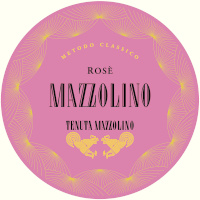
|
|
Oltrepo Pavese Metodo Classico Pinot Nero Rosé Cruasé 2012 |
|
| Tenuta Mazzolino (Lombardy, Italy) | |
 Pinot Nero Pinot Nero | |
| Price: € 18.00 | Score: |
 Brilliant cherry pink and nuances of onion skin pink, transparent, fine
and persistent perlage. Brilliant cherry pink and nuances of onion skin pink, transparent, fine
and persistent perlage.
 Intense, clean and pleasing, starts with hints of cherry, strawberry
and bread crust followed by aromas of strawberry, tangerine, plum and
praline. Intense, clean and pleasing, starts with hints of cherry, strawberry
and bread crust followed by aromas of strawberry, tangerine, plum and
praline.
 Effervescent and crisp attack, however balanced by alcohol, good body,
intense flavors. Effervescent and crisp attack, however balanced by alcohol, good body,
intense flavors.
 Persistent finish with flavors of cherry, raspberry and strawberry. Persistent finish with flavors of cherry, raspberry and strawberry. Refermented in bottle on its lees for 44 months. Refermented in bottle on its lees for 44 months. |
|
 Cold cuts, Pasta with fish, Sauteed white meat, Broiled crustaceans Cold cuts, Pasta with fish, Sauteed white meat, Broiled crustaceans |
|
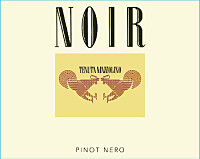
|
|
Oltrepo Pavese Pinot Nero Noir 2015 |
|
| Tenuta Mazzolino (Lombardy, Italy) | |
 Pinot Nero Pinot Nero | |
| Price: € 30.00 | Score: |
 Brilliant ruby red and nuances of garnet red, moderate transparency. Brilliant ruby red and nuances of garnet red, moderate transparency. Intense, clean, pleasing, refined and elegant, starts with hints of
cherry, plum and strawberry followed by aromas of raspberry, dried rose,
blueberry, chocolate, tobacco, vanilla, leather, pink pepper, mace and
menthol. Intense, clean, pleasing, refined and elegant, starts with hints of
cherry, plum and strawberry followed by aromas of raspberry, dried rose,
blueberry, chocolate, tobacco, vanilla, leather, pink pepper, mace and
menthol.
 Properly tannic attack and however balanced by alcohol, good body,
intense flavors, pleasing crispness. Properly tannic attack and however balanced by alcohol, good body,
intense flavors, pleasing crispness.
 Persistent finish with flavors of cherry, plum and strawberry. Persistent finish with flavors of cherry, plum and strawberry. 12 months in cask. 12 months in cask. |
|
 Roasted meat, Stewed meat with mushrooms, Hard cheese Roasted meat, Stewed meat with mushrooms, Hard cheese |
|
News |
|
In this section are published news and information about events concerning the world of wine and food. Whoever is interested in publishing this kind of information can send us a mail to our address.
|
AquavitaeReview of Grappa, Distillates and Brandy |
|
|
||||||||||||
Wine Guide ParadeMay 2019
|
| |||||||
Privacy Policy | |||||||


| Copyright © 2002-2024 Antonello Biancalana, DiWineTaste - All rights reserved |
| All rights reserved under international copyright conventions. No part of this publication and of this WEB site may be
reproduced or utilized in any form or by any means, electronic or mechanical, without permission in writing from DiWineTaste. |